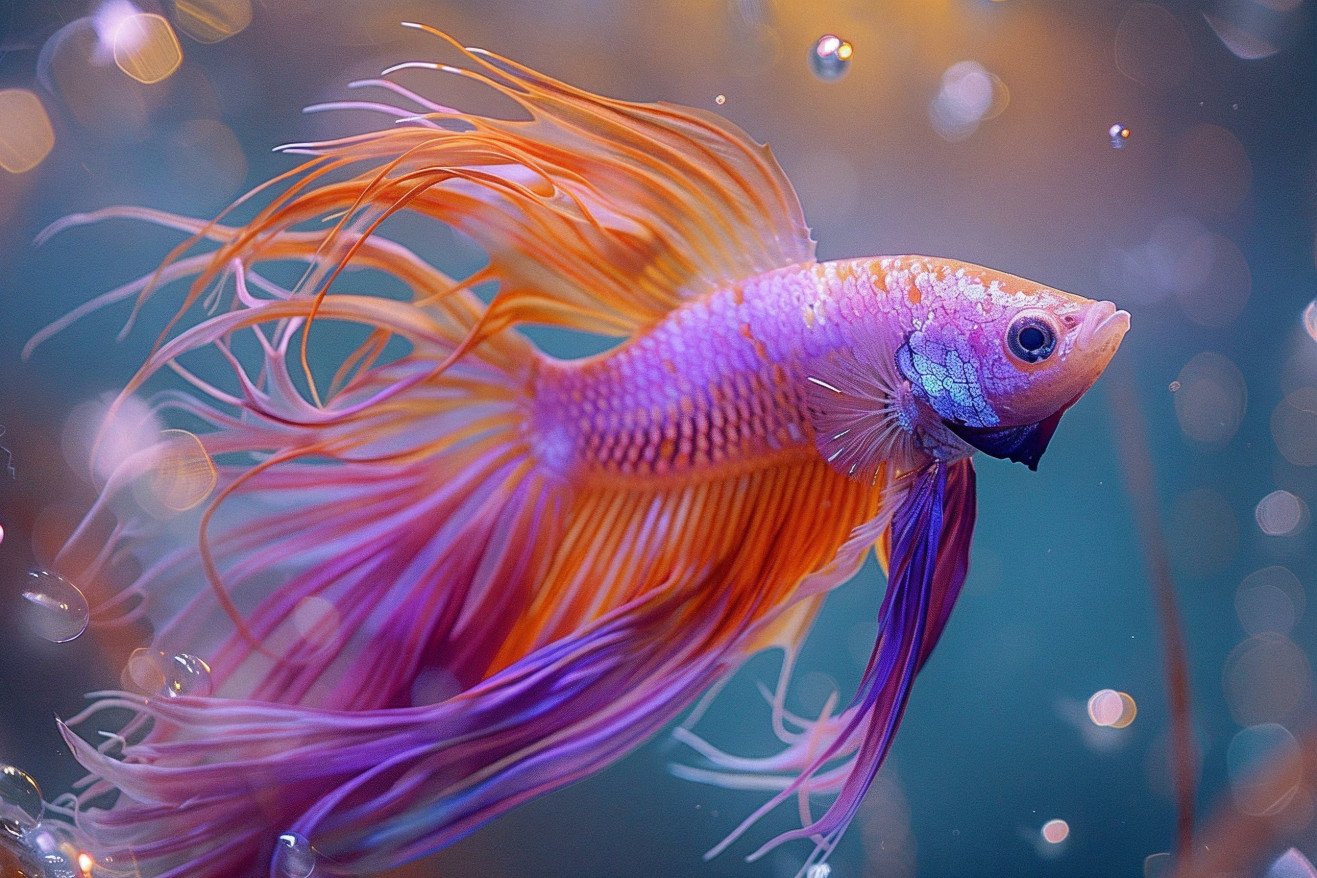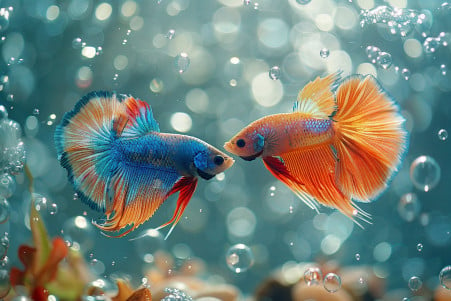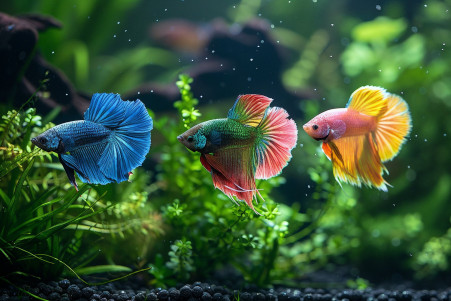Why Does My Male Betta Fish Make a Bubble Nest Without a Female? Understanding the Behavior
15 May 2024 • Updated 14 May 2024

If you’ve ever seen your male betta fish making a bubble nest without a female present, you may have wondered why he’s doing it. Male betta fish make bubble nests as a result of their natural breeding instincts, even if there are no females around. Bubble nests are complex structures made of bubbles that the male betta fish uses to protect and oxygenate the eggs he fertilizes during spawning.
Although it may seem odd, in this article, we’ll explore the interesting reasons why male betta fish make bubble nests even when there are no females to spawn with, based on scientific research. We’ll look at research in ichthyology, animal behavior, and evolutionary biology to understand the instincts and biological factors that drive this unusual behavior. You’ll come away with a deeper understanding of the fascinating reproductive behaviors of these colorful freshwater fish.
Why does my male betta fish make a bubble nest without a female?
What Bubble Nests Say About Betta Fish's Natural Breeding Instincts
Bubble nest building is an instinctive behavior that's hardwired into the genetics of male betta fish. As noted on Better Bettas, this instinct ensures the survival of the species by promoting successful reproduction. Even in captivity, where the conditions for breeding may not be right, male bettas will still feel the urge to build bubble nests as a way to prepare for mating.
In fact, the urge to build nests is so strong that some males will build them over and over again even when no female is around and there's no chance of breeding, according to UW Photo Ring. This mesmerizing behavior is a source of wonder for fish keepers around the world and indicates the betta's high energy level and the way it's mirroring its natural breeding cycle.
Recognizing these instincts is important because it helps people understand the importance of bubble nest building. As Betta Buzz notes, the nests are a sign of the male's fitness and attractiveness and are an important part of the reproductive strategies that have been shaped by evolution. Knowing this helps people see the deeper meaning behind what might seem like a strange aquatic phenomenon.
Environmental Factors That Influence Bubble Nest Building
While bubble nest building is an innate behavior in male betta fish, there are several environmental factors that can influence a fish’s willingness and ability to build a bubble nest. According to BettaFish Bay, water quality, temperature, and tank setup are all important factors that can either encourage or discourage bubble nest building.
Water quality is important for a number of reasons, including that it helps the male betta feel safe enough to build a bubble nest. This means that the water should have the right pH, low ammonia, and high dissolved oxygen levels, according to the Cuteness article. In addition, the water should be calm and well-filtered with minimal water movement, which can also encourage bubble nest building, according to the Betta Fish Forum discussion.
By learning about and adjusting these factors, you can increase the likelihood of seeing and promoting this interesting behavior in your male betta fish. This will help you and other aquarium hobbyists better understand the natural breeding behaviors of these beautiful freshwater fish.
How to Help and Troubleshoot Bubble Nest Building
If a male betta is not building a bubble nest, it's important to make sure that the tank is set up in a way that is conducive to bubble nest building and that the water quality is good. As noted on BettaFish Bay, the first thing to do is to make sure that the water quality, temperature, and tank setup are all in good shape so that any potential issues can be addressed.
As the Cuteness article explains, floating plants, the right substrates, and a lower water level can all help encourage bubble nest building by creating the right kind of environment. In other cases, a male betta may not build a bubble nest due to age, stress, or a lack of natural breeding instinct, and this is not necessarily a problem, as noted in the Betta Fish Forum discussion.
Knowing why a male betta may not be building a bubble nest can help you make sure that you're doing what you can to encourage the behavior or make sure that you're not worried if it doesn't happen.
Taking Care of Betta Eggs and Fry After Bubble Nest Building
After a male betta has built a bubble nest and successfully mated with a female, it's important to take good care of the eggs and fry. According to Beautiful Bettas, the male betta will watch over the eggs and fan them to prevent fungus from growing on them. The eggs will hatch within 36-48 hours. At first, the fry will sink to the bottom, but they will be able to stick to the glass or the bubbles in the nest within 12 hours.
The fry will be free-swimming after about 2 days, and the male can be removed with care to prevent him from eating the fry, according to the Betta Fish Forum discussion. It's important to keep the water clean and healthy, feed the fry the right food, and watch their progress to make sure they survive and thrive, according to the Betta Breeding Forum thread.
Breeding Bettas Without a Bubble Nest: Risks and Considerations
While male betta fish typically build bubble nests as part of the breeding process, it is possible for them to reproduce without constructing a nest. However, breeding without a bubble nest is generally not recommended, as the nest provides crucial protection and oxygenation for the eggs and fry. As noted in the Betta Breeding Forum, attempting to breed bettas without a nest can result in lower hatch rates and poorer fry survival, as the eggs and fry are more vulnerable to environmental factors.
In some rare cases, male bettas may use alternative methods, such as duckweed or other floating materials, to create a makeshift nest for their eggs and fry, as highlighted in the Betta Fish Forum discussion. However, if a male betta does not build a nest, it is essential to carefully monitor water conditions and consider alternative methods for protecting and oxygenating the eggs and fry, as suggested in the BettaSource article.
Conclusion: The Science of the Betta's Bubble Nest
The male betta fish's construction of bubble nests is a complex behavior that has deep roots in the species' evolutionary adaptations and innate breeding instincts. Although it may seem strange at first, the behavior is an essential part of the betta's reproductive cycle, providing a safe, oxygen-rich environment for the species' eggs and fry.
To promote and support the construction of bubble nests, it's important to understand the many factors that influence the behavior, including the male betta's natural drives and the conditions in its environment. It's also important to understand how to care for the eggs and fry after the nest is built to ensure that the species can continue to thrive.
By learning about the science behind the betta's bubble nest, we can gain a deeper understanding of the complex mechanisms and strategies that the species has developed over time.


